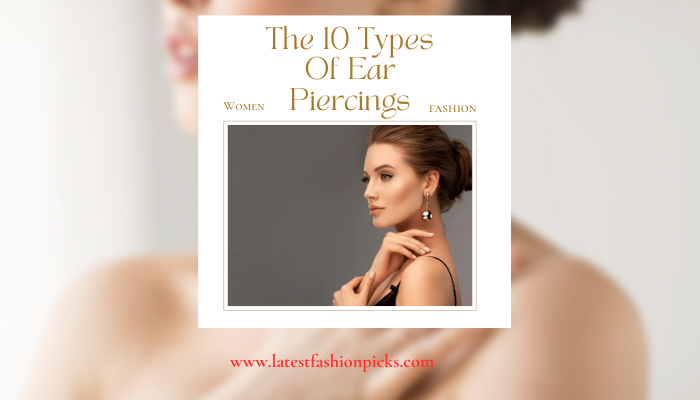Ear piercings are a form of body modification that has been practiced for centuries, with each piercing style offering its own unique aesthetic appeal. The 10 types of ear piercings whether you're considering adding to your ear jewelry collection or simply intrigued by the various options available, understanding the different types of ear piercings can help you make an informed decision. From the classic lobe piercing to the more adventurous industrial piercing, here are ten popular ear piercing styles to explore.
The 10 Types Of Ear Piercings
1. Standard Lobe Piercing

Ah, the straditional lobe piercing. Brooks states, We all know and like a nice lobe piercing. I continually encourage these. The lobe is the simplest component of the ear to repair. The lobe is also the least painful—about one or two out of 10.
You can change the jewelry after three months of heal time, Brooks tells me. She adds, In general, people have enough space to do something unique with their piercing placements.
Design and aesthetics are really important to me, therefore I've enjoyed assisting customers in achieving a creative design that matches them and their lifestyle.
Read also: Best Stylish Workwear Ideas For Women
2. Helix Piercing

A helix piercing involves piercing the top cartilage of the ear, usually around the outer rim. This piercing may be put anywhere along the helix, allowing for individualization based on choice.
Hoops, studs, and captive bead rings are popular options for helix piercings, providing limitless possibilities for creative expression.
3. Forward Helix Piercing

A forward helix is another cartilage piercing that is performed on the top ear over the tragus. T
hese piercings are more difficult than traditional helix piercings since the piercing must be exactly aligned with your ear and will most likely pain more than a conventional lobe piercing.
4. Tragus Piercing

The tragus piercing involves piercing the small, thick piece of cartilage that protrudes from the ear canal.
This piercing has gained popularity in recent years for its unique placement and ability to complement other ear piercings.
Tragus piercings are often adorned with dainty studs or small hoops, adding a subtle yet stylish touch to the ear.
Read also: Fashion Trends For Women Over 40
5. Anti-Tragus Piercing

Opposite to the tragus piercing, the anti-tragus piercing is located on the outer rim of the ear, just above the earlobe.
This piercing offers a bold and edgy look that can enhance the overall symmetry of the ear.
While anti-tragus piercings require careful placement due to the limited space available, they can be adorned with a variety of jewelry styles to suit individual tastes.
6. Conch Piercing

The conch piercing is situated in the central part of the ear cartilage, known as the concha.
This piercing can be done on either the inner or outer conch, offering versatility in terms of placement and jewelry options.
From minimalist studs to statement-making hoops, conch piercings can be customized to reflect personal style preferences.
7. Daith Piercing

A daith piercing involves piercing the innermost fold of cartilage in the ear, known as the crus of the helix.
This piercing has gained attention for its potential therapeutic benefits in alleviating migraines, although scientific evidence supporting this claim is limited.
Despite the controversy, daith piercings remain a popular choice for those seeking a unique and eye-catching ear piercing.
8. Rook Piercing

Situated along the inner ridge of the ear cartilage, the rook piercing offers a subtle yet distinctive look. This piercing is typically adorned with curved barbells or captive bead rings, highlighting its placement in the upper ear fold.
Rook piercings can add depth and dimension to the ear, making them a favored option among piercing enthusiasts.
9. Snug Piercing

The snug piercing, also known as the anti-helix piercing, is located along the inner ridge of the ear cartilage, parallel to the helix. This piercing requires precise placement to ensure a comfortable fit and optimal healing.
Snug piercings can be adorned with curved barbells or captive bead rings, creating a striking visual effect that draws attention to the upper ear.
Read also: Top Fashion Styling Ideas for Curvy Women: Look Confident & Stylish
10. Industrial Piercing

The industrial piercing, also referred to as a scaffold or construction piercing, involves connecting two piercings with a single piece of jewelry.
Typically, this piercing consists of a straight barbell that traverses the upper ear cartilage horizontally. Industrial piercings offer a bold and modern look that showcases the wearer's unique sense of style.
Conclusion
In conclusion, ear piercings offer a diverse range of options for individuals looking to express themselves through body modification. Whether you prefer the simplicity of a standard lobe piercing or the intricacy of an industrial piercing, there's a piercing style to suit every taste and preference. Before getting pierced, be sure to research reputable piercing studios and consult with a professional piercer to ensure a safe and successful experience.
FAQ's: The 10 Types Of Ear Piercings
Q. Are ear piercings painful?
Ans: Pain levels can vary depending on individual tolerance and the location of the piercing. However, most people describe the sensation as brief discomfort rather than intense pain.
Q. How long does it take for an ear piercing to heal?
Ans: Healing times can vary depending on the type of piercing and individual factors. On average, ear piercings can take anywhere from several weeks to several months to fully heal.
Q. Can I change my earrings immediately after getting pierced?
Ans: It's essential to follow the aftercare instructions provided by your piercer and wait until the piercing has fully healed before changing earrings to avoid irritation or infection.
Q. What should I do if my ear piercing becomes infected?
Ans: If you suspect your piercing is infected, it's crucial to seek medical attention promptly. Avoid removing the jewelry yourself, as this can trap bacteria and worsen the infection.
Q. Are there any risks associated with ear piercings?
Ans: Like any body modification procedure, ear piercings carry some risks, including infection, allergic reactions, and prolonged healing times. However, these risks can be minimized by choosing a reputable piercer and following proper aftercare guidelines.








.webp)